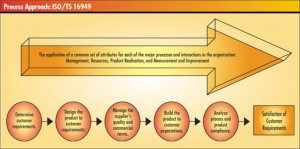After travelling along parallel paths for many years, the automotive industry and its suppliers have merged into a single line. TS16949 is the culmination of that effort. Officially known as ISO/TS-16949:2009, this international automotive quality system specification aligns the entire supply chain with the automakers to create continuity across a now-global industry.
When ISO 9000 was introduced, auto manufacturers from each country took it upon themselves to codify their manufacturing processes and build an automotive quality system specific to that country. In the United States, for example, qs9000 was developed by the big three – Ford, GM, and Chrysler – to set expectations for suppliers to the US Auto Industry. Germany, France, and Italy did the same, each setting up their own national standards. The qs9000 standard, as well as the European standards, consisted of three sections with which suppliers had to comply. The first part was a regurgitation of the ISO 9000 standard, the second part included manufacturer-independent quality control measures that had to be in place, and the third part was written to provide manufacturer-specific requirements above and beyond the general compliance requirements.
Suppliers were required to comply with the automotive quality system of the country with which they did business. This placed a tremendous burden on non-affiliated suppliers, who had to keep separate sets of quality-control records to prove compliance for each manufacturer. On top of that, any supplier who provided parts to multiple countries had to keep additional sets of records to maintain compliance with the standards of each country as well. This required cumbersome quality control management systems, and kept part and supply costs high for the automakers.
To help reduce this burden on suppliers and control the associated costs to the industry, the International Automotive Task Force (IATF), consisting of manufacturers and trade groups from around the world, worked in conjunction with ISO to develop a unified standard, TS 16949. While TS16949 still keeps the same three parts – ISO standard language, automotive industry general quality standards, and manufacturer-specific requirements – most European and North American auto manufacturers have adopted this standard, and have phased out their nationally-based standards in favor of this international automotive quality system specification. TS 16949 has been through two revisions since it was first introduced, each bringing it more into alignment with the ISO standards.
TS 16949 sets out a process-approach to customer satisfaction by including requirements such as a specific process for measuring the level of customer satisfaction, a method of continual improvement and cost reduction, and compliance demonstration for each customer. There is also a major emphasis on employee satisfaction in this standard that did not exist in the individual national standards or in ISO standards. Methods for measuring employee satisfaction, motivation, and awareness of their effect on the final quality of the product are all required by ts16949. It applies to every process that adds value to a product as it works its way through the supply chain to the manufacturing plant, including services, maintenance, part treatment and finishing, and component sub-assembly.
Companies wishing to do business with American and European auto manufacturers must be certified TS 16949-compliant. Even Asian manufacturers who have assembly plants in these countries are getting on-board with the standard. The benefits for a company so certified go well beyond the auto industry however. Certification demonstrates to other potential customers that the supplier/provider is committed to quality and can maintain standards at the highest levels, has better control over its engineering, manufacturing, continuous improvement, and employee involvement than its competitors, and that it has a high level of customer understanding and perception.
back to What is ISO?
